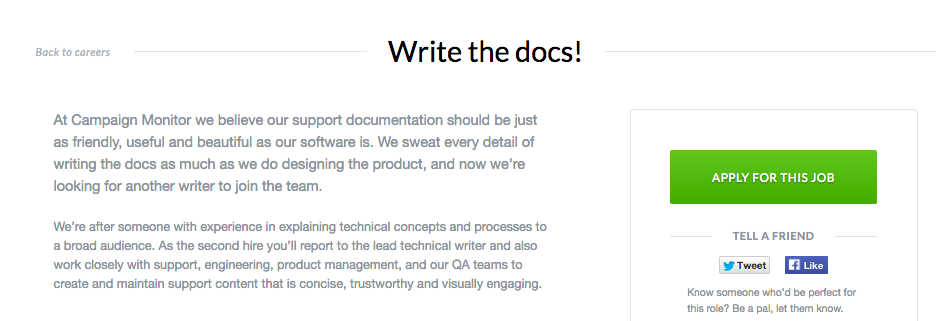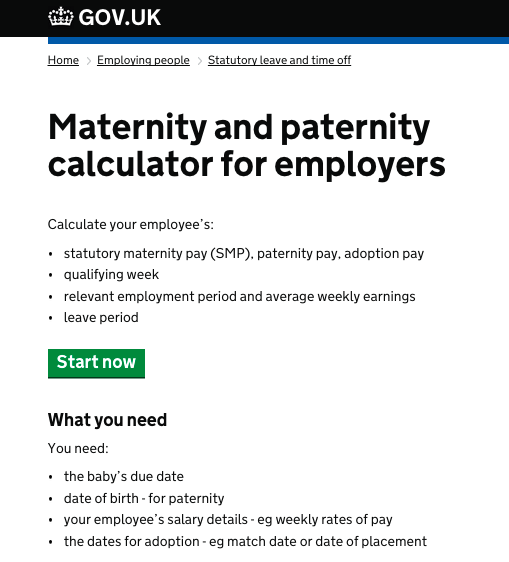As a team of passionate self-service advocates, we’re surprised that most people don’t see technical writing and content strategy in a similar light.
It’s as if people believe that the need for smart, organized content ends when a prospect becomes a customer. Sure, content strategy exists to convert and sell, but it takes strong, well-written documentation to build and retain customers. One communicates a world of possibilities and the other helps the customer realize them.
So what is support’s content strategy, and how can we turn it into knowledge base best practices?
Your Support Voice Is an Extension of Your Brand
To answer this question, let’s look at a brand that’s managing their strategy the right way. Campaign Monitor, an email campaign platform, treats technical writing as a natural extension of their brand and product. This job description shows the care and planning that goes into their support content strategy.

Campaign Monitor’s ideal technical writer
“You are a perpetual learner with a passion for technology and user experience. You know how to ask intelligent questions and interpret the answers. Maybe you’ve been accused of nitpicking—how things work, how a restaurant menu is punctuated, how the TV guide is formatted—but it’s only because of your meticulous attention to detail and obsession with continuous improvement.
At work, you use these strengths to identify content and process improvement opportunities that will make life easier for everyone on the team and impress the socks off of customers.
You’re also motivated to work independently, enthusiastic about co-authoring docs and willing to roll up your sleeves and do whatever’s necessary to meet team goals.”
Here are a few reasons why Campaign Monitor’s approach to the technical writer role is ahead of the curve:
Experience Explaining Technical Concepts Required
This is often a job that falls on either engineers or the marketing and communications team. However, this doesn’t work because typically, engineers don’t have writing experience and the marketing team doesn’t have enough product familiarity.
Emphasis on Collaboration
This is not a solo job. It’s a collaborative role, rather than a siloed role for engineers, with teams across the company contributing to final outputs. Marketing, PR, product, project and legal teams may be involved.
Calling on Creative Skills to Make Support Content Concise and Engaging
This job calls on the same creative and UX skills of a marketer, rather than a technical expert. Can a concept be better explained visually? Can you make it more interesting with a GIF or an infographic?
This forward-thinking role at Campaign Monitor is redefining knowledge management. Technical writers must understand what customers are trying to achieve and why and use that to communicate solutions.
Simple Should Be Your Default Starting Point
The best support is your customers not needing support at all if you can manage to achieve that.
Failing that, the second-best support enables customers to resolve their case or figure out next steps as quickly as possible.
That’s why developing clear content to answer common questions is so effective.
Think about how broad the audience is for the UK government website. It needs to serve the United Kingdom’s entire population. The team behind the redesign set out to build a site that was accessible to the broadest audience possible, including non-native English speakers, the elderly and the visually disabled.

Look at how easy and straightforward it is to obtain an answer to maternity pay entitlement. This page tells you what you need.
Their efforts won them the Design of the Year award.
The website’s design team says, “You shouldn’t have to understand how government works to be able to interact with it. Government and the services it provides are often complicated, so we should hide complexity where possible.”
If the UK can make its bureaucratic rules and regulations accessible to an entire nation, your business can (and should) do the same for your user base.
How to Make Sure You’re Writing for the Right Audience
First, ask your marketing team for demographic information and user personas that help you determine your audience. Then you need to do more digging to make sure you’re writing for the folks who will actually be using your knowledge base.
Your CTO might buy a CRM but it’s the sales team that uses it day in and day out. Your audience may not have the baseline knowledge you assume they have. The people who buy your services might not represent your end users.
It’s worth going straight to the audience to find out who you’re really talking to. The easiest way to do this is by conducting a survey of users who have either contacted your support team or used your self-service tools. Any of the following would work:
- A Foresee-powered survey
- A quick question at the end of a live agent interaction
- A follow-up email sent to a sample of customers who recently had a support interaction
Collect key details about your customers like age, tech literacy, their primary reason for using the product or service and education level. This will help you find the appropriate voice for your knowledge base.
What’s Your Knowledge Base Writing Style?
Your self-service knowledge base should be part of your overall content strategy, not exiled to its own domain.
When you know your audience, you can adjust the tone and style of your content to speak to users in a way that connects with them. Your product support is as important as the product itself. That’s why we predict that there will be an increasing need for interdisciplinary writing and smart, savvy communication increase along with rising user expectations.
We would even argue that the way you support your customers is more important than the way you market to them. Your support strategy is essentially your retention strategy. If you want loyal customers, give your self-service content strategy the time and attention it deserves.
